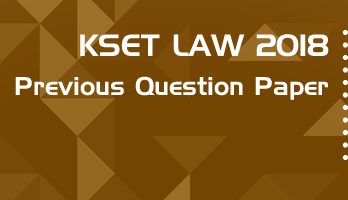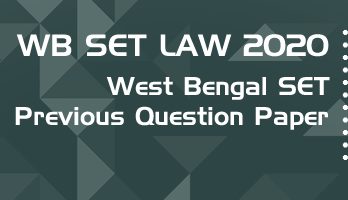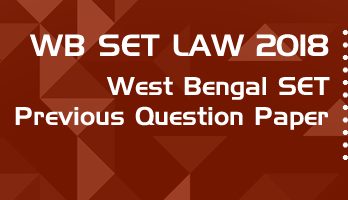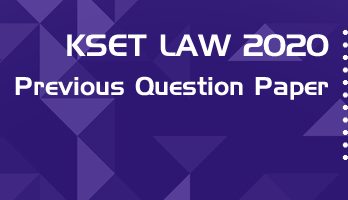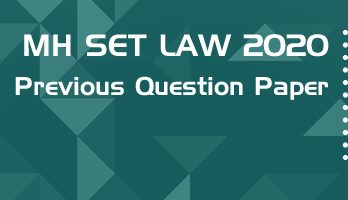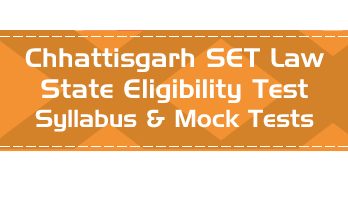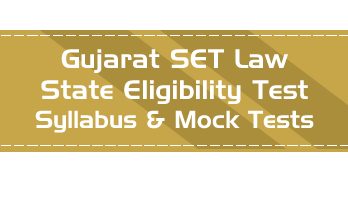- Based on latest Maharashtra State Eligibility Test Law Paper II Syllabus
- Law Subjects Overview Material covering important topics and concepts - 650 page PDF Book
- 50 Full Length Mock Tests - New Pattern Paper II, with 100 questions each
- 50 Mini Practice Mock tests - with 25 questions each
- Unlimited Practice - New Questions in every mock test with every attempt
- Answer choices of all questions shuffled randomly for better practice
- Database of over 9500 MCQs covering the entire syllabus
- Includes new comprehension based questions
- Questions & Answer Choices randomly shuffled in every attempt for better practice
- Accessible 24 x 7 via Smart-Phone browsers and Desktops
"Just wanted to let you know that I have cleared JRF with 99.99th percentile. Thank you for all your help and support that made it possible. " - Kanchan Yadav
"Thank you so much for the UGC NET test series. I finally qualified the exam. It was possible because of the mock test series provided by your team." - Robin Jaiswal
This is the full previous question paper from MH-SET 2018 Paper III Law Subject, i.e. the Maharashtra State Eligibility Test examination conducted in 2018 for eligibility for Assistant Professor posts in Maharashtra & Goa.
The official answer key for this question paper, along with other all recent previous papers and 100 Mock tests / model papers with unlimited practice are included in our online MHSET Law Online Practice Pack.
1# Which of the following is not an essential feature of the Constitution of India ?
A# Distribution of legislative powers between Union and State Government
B# Incorporation of policies which are fundamental in the Governance of the country
C# Specific Articles for defining various powers, privileges and immunities of each House of the Parliament and its committees
D# Specific Article for giving binding effect to the law declared by the Supreme Court
2# In the case of inconsistency between laws made by Parliament and laws made by state legislatures, which one of the following shall prevail ?
A# The law made by parliament before the law made by the legislature of the State
B# The law made by the Parliament after the law made by the legislature of the state
C# The law made by the Parliament irrespective of the fact whether the law made by the legislature of the State is before or after the law made by the Parliament
D# The law made by the legislature of the State
3# The ‘doctrine of eclipse’ has been held apply only to :
A# Post-Constitutional Laws
B# Pre-Constitutional Laws
C# Post-Constitutional Criminal Laws
D# Pre-Constitutional Criminal Laws
4# Which of the following statements regarding Article 22 of the constitution are correct ?
(1) The right conferred by the Article protects persons against arrest and detention.
(2) The right is guaranteed both to citizens and non-citizens.
(3) The rights guaranteed under this Provision are applicable to those arrested under laws providing for preventive detention.
(4) The rights guaranteed under this provision are not applicable to enemy aliens.
A# (1), (2) and (3)
B# (1) and (4)
C# (1), (2) and (4)
D# (1) and (3)
5# Read Assertion (A) and Reason (R) and with the help of codes given below, point out correct explanation.
Assertion (A) : The rights guaranteed under Article 19(1) are subject to reasonable restrictions which may be imposed by the state under Articles 19(2) to 19(6).
Reason (R) : The rights guaranteed under Article 19(1) are not absolute.
A# (A) is correct, (R) is false
B# (A) is false, (R) is true
C# Both (A) and (R) are true but (R) is not correct explanation of (A)
D# Both (A) and (R) are true and (R) is the correct explanation of (A)
6# What is the correct chronological sequence of the following advisory opinions given by the Supreme Court under Article 143.
(1) In re Special Courts Bill
(2) In re Berubari Union
(3) In re Delhi Laws Act
A# 3, 2, 1
B# 1, 2, 3
C# 1, 3, 2
D# 2, 1, 3
7# The proclamation of emergency may be declared if the President of India is satisfied that a grave emergency exists whereby the security of India or of any part of the territory there of threatened by :
A# War or external aggression
B# War or armed rebellion
C# War or external aggression or armed rebellion
D# External aggression or armed rebellion
8# Which of the following statements is correct ?
A# Chief Election Commissioner and State Election Commission are Constitutional Authorities
B# President of India is competent to appoint Chief Election Commissioner and State Election Commission
C# State Election Commission is under the control of Chief Election Commissioner
D# From the decisions of the State Election Commission appeal shall lie to Election Commission of India
9# According to _______ , ‘Administrative law is the law relating to the Administration which determines the organisation, powers and duties of administrative authorities’.
A# Dicey
B# Sir Ivor Jennings
C# Griffith
D# Maitland
10# Find out which of the following statements is/are correct ?
Statement (I) : The Indian Administrative law is basically common-law oriented as the Administration is subject to judicial control.
Statement (II) : It has also imbibed some features of Droit Administratif which can be established in the light of the acceptance of doctrines of ‘legitimate expectation’ and ‘proportionality’ to some extent in Indian Administrative Law :
A# Both (I) and (II) are correct
B# Both (I) and (II) are incorrect
C# (I) is correct but (II) is incorrect
D# (I) is incorrect but (II) is correct
11# In which of the following cases the distinction between quasi-judicial and administrative decisions was perceptively mitigated and was held that even an administrative order or decision in matters involving civil consequences, has to be made consistent with the rules of natural justice ?
A# Western India Watch Co. Vs Its Workers
B# R.R. Verma Vs Union of India
C# State of Orissa Vs Dr. Binapani Dei
D# Mahabir Jute Mills Vs Shibben Lai Saxena
12# Writ of Mandamus cannot be issued, where a fundamental right is infringed by :
A# A Statute
B# A Statutory Order
C# An Executive Order
D# Private Body
13# Administrative Tribunals exercise ________ functions.
A# Purely Administrative
B# Purely Judicial
C# Purely Legislative
D# Quasi-Judicial
14# In which of the following conditions the Writ of Prohibition may be issued ?
A# Where there is absence or abuse of jurisdiction
B# Where there is violation of principles of Natural Justice and fraud
C# Where there is any kind of contravention of the law of the land
D# Both Where there is violation of principles of Natural Justice and fraud and Where there is any kind of contravention of the law of the land
15# The Administrative Reforms Commission after carefully evaluating the pros and cons advocated the adoption of the Ombudsman-type institution in India way back in :
A# 1956
B# 1976
C# 1966
D# 1986
16# According to Natural law theories, in general is the source of law.
A# Legislation
B# Precedent
C# Customs
D# Morality
17# Doctrine of ‘lifting of corporate veil’ is associated with :
A# Corporate personality
B# Corporate management
C# Corporate finance
D# Corporate social responsibility
18# Austin described ‘ownership’ as a ‘right’ over a determinate thing.
A# Indefinite
B# Unrestricted
C# Unlimited
D# All of the choices
19# In _________ , the Supreme Court of India adopted the doctrine of prospective overruling.
A# Kesavananda Bharati case
B# A.K. Gopalan case
C# Golak Nath case
D# Maneka Gandhi case
20# According to Dias, ‘ratio decidendi’ means the
A# Reason for/of decision
B# Rule of law offered by the judge as the basis of his decision
C# Rule of law which others regard as being of binding authority
D# All of the choices
21# The Supreme Court has asserted that Art is the heart of the Fundamental Rights.
A# 12
B# 19
C# 21
D# 38
22# The author of ‘The Enforcement of Morals’ is :
A# Lord Devlin
B# Lord Lloyd
C# H.L.A. Hart
D# Lon Fuller
23# Which of the following is meaning of the maxim ‘Actus me invite factus non est mens actus’.
A# Merely a voluntary act by me will not be a crime with a criminal intention
B# An act done by me against my will is not my act
C# Neither I nor my person can be held liable for an act done under compulsion
D# All of the choices
24# Match List I with List II and select the correct answer using codes given below it :
List-I
(a) Instigating a person to commit an offence
(b) Planning to commit a theft
(c) An unlawful act without criminal intention
(d) Liability for act of another
List-II
(1) Vicarious Liability
(2) Abetment
(3) No offence in itself
(4) Strict criminal liability
Select the answer choice corresponding to the order (a) (b) (c) (d) :
A# (2) (1) (4) (3)
B# (2) (3) (4) (1)
C# (3) (4) (1) (2)
D# (4) (3) (2) (1)
25# According to Section 107, a person abets the doing of a thing when he :
A# Instigates a person to commit an offence
B# Engages with one or more persons in a conspiracy to commit an offence
C# Intentionally aids, by an act or illegal omission, the doing of that thing
D# All of the choices
26# Which of the following is not main ingredients of principle of joint liability under Section 34 of IPC.
A# A criminal act must be done by several persons
B# The criminal act must be furtherance of common object
C# The criminal act must be to further the common intention of all and
D# There must be participation of all persons in furthering the common intention
27# Which of the following is not an essential element of Theft U/S 378 of IPC.
A# Dishonest intention to take property out of that person’s possession
B# The property must be moveable
C# Take possession with the consent of owner
D# Moving property in order to such taking
28# For conspiracy, the minimum number of person required is :
A# One
B# Two
C# Three
D# Five
29# Culpable homicide is causing death :
A# With the intention of causing death
B# With the intention of causing such bodily injury as is likely to cause death
C# With the knowledge that by such act death is likely to be caused
D# All of the choices
30# Assertion (A) : Whoever, by words either spoken or intended to be read or by signs or by visible representations, makes or publishes any imputation concerning any person intending to harm, or knowing or having reason to believe that such imputation will harm, the reputation of such person.
Reason (R) : Imputation of truth which public good requires to be made or published.
A# (A) is true but (R) is untrue
B# (A) is true but (R) is not correct explanation of (A)
C# (A) is untrue but (R) is correct explanation of (A)
D# Both (A) and (R) are true
31# The Earth Summit held at Rio-de-Janeiro, Brazil was on :
A# The control of Transboundary Movements of Hazardous waste
B# United Nations Conference on Environment and Development
C# United Nations Conference on the Human Environment
D# None of the choices
32# The CPCB (Central Pollution Control Board) is constituted under :
A# Section 3(1) of the Environment (Protection) Act, 1986
B# Section 3(1) of the Water (Prevention and Control of Pollution) Act, 1974
C# Section 4(3) of the Environment (Protection) Act, 1986
D# Section 7(1) of the Air (Prevention and Control of Pollution) Act
33# In the light of definition of ‘Environment pollutant’ under the Environment (Protection) Act, 1986, which one of the following statements is not correct :
A# Environment pollutant is any substance or preparation which may, by reason of its chemical or physio-chemical properties or handling is liable to cause harm
B# Environment pollutant is any solid, liquid or gaseous substance present in such concentration as may be or tend to be injurious to environment
C# Environment pollutant is a substance, which is poisonous, hazardous and injurious to human safety
D# Environment pollutant is a substance which is chemically explosive, contagious, destructive or non-reactive and non-useful for the living being on earth
34# Acid rain has been increasing day by day due to :
A# Urbanisation
B# Industrialisation
C# Increase in vehicle population
D# None of the choices
35# Which amongst the following is not the policy document related to environment protection ?
A# The Nation Forest Policy, 1988
B# Policy statement for Abatement of Pollution, 1992
C# The National Conservation Strategy and Policy Statement on Environment and Development, 1992
D# The National Policy Document for Sustainable Development and Conservation of Forest and Environment, 1967
36# The Environment (Protection) Act, 1986 was enacted inter alia, to implement the provisions of in India.
A# United Nations Conference on the Human Environment held at Stockholm
B# United Nations Conference on Environment and Development (UNCED) known as Earth Summit held at Rio de Janeiro
C# United Nations Conference on Sustainable Development held at Johannesburg
D# Basal Convention
37# The bio-medical waste is used to be regulated in India by which of the legislation ?
A# The Water (Prevention and Control of Pollution) Act, 1974
B# The Bio-Medical Waste (Management and Handling) Rule 1998
C# The Air (Prevention and Control of Pollution) Act
D# The Environment (Protection) Act, 1986
38# The ‘Cigarettes and other Tobacco Products (Prohibition and Advertisement and Regulation of Trade and Commerce, Production, Supply and Distribution) Act’ was enacted in the year :
A# 2000
B# 2003
C# 2009
D# 2001
39# When did the World Trade Organization come into force ?
A# 1992
B# 1995
C# 1998
D# 2000
40# Which of the following organs of the United Nations has lost its relevance in the contemporary times ?
A# Economic and Social Council
B# Secretariat
C# Trusteeship Council
D# General Assembly
41# Which of the following statements is correct ?
A# All members of the United Nations are ipso facto parties to the Statute of ICJ
B# A state which is not a party to the U.N. Charter cannot become a party to the statute of the ICJ
C# The ICJ has jurisdiction only in contentious cases
D# The judgements of ICJ are recommendatory in nature
42# A refugee may not be repatriated to his state of origin if there is a risk of his death or persecution. The aforesaid statement is known as :
A# Principle of non-refoulement
B# Pacta sunt servanda
C# Rebus sic stantibus
D# Opinio juris sive necessitatis
43# ‘General Assembly resolutions, even if they are not binding, may sometimes have normative value. They can, in certain circumstances, provide evidence important for establishing the existence of a rule or the emergence of an opinio juris’ In which of the following cases/ advisory opinions, the aforesaid observation was made by the ICJ ?
A# Corfu channel case, 1949
B# International status of South-West Africa case, 1950
C# Libyan Arab Jamahiriya V. Malta, 1985
D# Legality of the Threat or use of Nuclear Weapons, 1996
44# Which of the following statements is incorrect about recognition ?
A# Recognition de facto implies that there is some doubt as to the long-term viability of the government in question
B# Recognition de jure follows where the recognizing state accepts that the effective control displayed by the government is permanent
C# Recognition can only be given in express terms, that is in the form of an open and formal communications
D# Recognized state gets rights of suing in the municipal courts of the recognizing state
45# Which of the following statements is incorrect with respect to sovereign equality as per the 1970 Declaration on Principles of International Law Concerning Friendly Relations and Co-operation among states in accordance with the UN Charter ?
A# States are juridically equal
B# Each state enjoys the rights interested in full sovereignty
C# Each state may not have the right freely to choose and develop its political, social, economic and cultural systems
D# Each state has the duty to comply fully and in good faith with its international obligation and to live in peace with other states
46# Which of the following judgements was nullified in effect by Muslim Women (Protection of Rights on Divorce) Act 1986 ?
A# Daniel Latifi’s case
B# Shah Bano’s case
C# Sarla Mudgal case
D# Ayesha’s case
47# A Shia male can contract a muta marriage with :
A# A Christian woman
B# A Jew woman
C# A Muslim woman
D# All of the choices
48# The role of the delegates in the Parsi matrimonial disputes is to :
A# decide the applications
B# to assist the courts in adjudication
C# to verify the documents
D# to advise the parties
49# Match List-I with List-II and select the correct answer :
List-I
(a) Gita Hariharan Vs RBI
(b) Daniel Latifi Vs UOI
(c) Dastane Vs Dastane
(d T. Saritha Vs Venkata Subbaih
List-II
(1) Cruelty as a ground of divorce
(2) Mother as a natural guardian even though the father is alive
(3) Restitution of conjugal rights
(4) Constitutional validity of Muslim Women (Protection of Rights on Divorce) Act, 1986
Select the answer choice corresponding to the order (a) (b) (c) (d) :
A# (2) (1) (4) (3)
B# (1) (2) (3) (4)
C# (2) (4) (1) (3)
D# (1) (3) (4) (2)
50# Which one of the following will not be a ground for maintenance if a Hindu wife lives separate from her husband for a justifiable cause :
A# Desertion
B# Leprosy
C# Husband keeps a concubine
D# Husband had huge debts
51# Khyal-ul-bulugh refers to :
A# Dissolution of marriage
B# Option of puberty by minor woman on attaining majority
C# Wilful refusal to consummate the marriage
D# Lack of consent in marriage
52# Doctrine of Relation Back results to :
A# Adoption of a son by a widow under the authority of her husband is deemed to have been adopted on the day the husband died
B# The relation between the married couple to their forefathers
C# The alienation of property becomes valid from the back date of alienation
D# None of the choices
53# A guardian who has been deprived of the custody of his wards, has the following remedies open to him :
(1) Writ of habeus corpus within the original civil jurisdiction of a High Court
(2) Application to a Magistrate under Section 97, 98 of Criminal Procedure Code 1973
(3) Regular suit by guardian for custody of the ward
(4) No need to recourse to legal action
Select the answer choice corresponding to the order (a) (b) (c) (d) :
A# (1) and (2) only are correct
B# (1), (2), (3) are correct and (4) is incorrect
C# (3) and (4) only are correct
D# (2) and (3) only are incorrect and (1) is correct
54# Internationally which document for the first time adopted the words ‘human rights’ ?
A# UDHR
B# ICCPR
C# UN Charter
D# League of Nations Covenant
55# Assertion (A) : The Child Rights Commission defines that any person below 18 years is eligible to be referred as a ‘child’ universally.
Reason (R) : Different states in the world define the age of child according to their own perspective.
Select the answer choice corresponding to the order (a) (b) (c) (d) :
A# Both (A) and (R) are true. (R) is the correct explanation
B# Both (A) and (R) are true. (R) is not the correct explanation of (A)
C# (A) is correct but (R) is wrong
D# (A) is not correct but (R) is correct
56# In which year the League of Nations adopted Geneva Declaration of the Rights of Child ?
A# 1936
B# 1926
C# 1928
D# 1924
57# Which International Document called for the establishment of National Human Rights Commission at the domestic level of a State ?
A# Geneva Principles
B# Paris Principles
C# New York Principles
D# New Delhi Declaration Principles
58# Who is the present High Commissioner of UNHCR ?
A# Ban-Ki-Moon
B# Rud Lubbers
C# Filippo Grandi
D# Sadako Ogata
59# From the below statements, which statement clearly defines the distinction between ‘Vertical’ and ‘horizontal’ human rights ?
A# Economic, social and cultural rights are part of human rights
B# Group Rights are part of Human Rights
C# Human Responsibilities are not part of human rights
D# Responsibilities of states under international law of human rights are part and parcel of human rights
60# Which Section of the NHRC Act cases the jurisdiction of both National and State Human Rights Commissions to inquire into the violations of human rights after the expiry of one year from the date of occurrence ?
A# Section 36
B# Section 37
C# Section 38
D# Section 30
61# In which case the Supreme Court of India held that UDHR was not formed part of Indian Municipal Law.
A# Raj Narayanan V. Union of India
B# Maneka Gandhi V. Union of India
C# A.D.M. Jabalpur V. Shivkant Shukla
D# Visakha V. State of Rajasthan
63# ‘A tort is a civil wrong for which the remedy is a common law action for unliquidated damages and which is not exclusively the breach of a contract or the breach of trust or other nearly equitable obligation.’ This definition has been prescribed by :
A# Dr. Winfield
B# Sir Frederick Pollock
C# John Salmond
D# Lord Denning
63# Match the List-I and List-II and select the correct answer using the codes given below it :
List-I
(i) Salus populi suprema lex
(ii) Respondent superior
(iii) Damnum sine injuria
(iv) Volenti non fit injuria
List-II
(a) Plaintiff is not entitled for compensation if he voluntarily taken the risk
(b) Held the master liable as all the acts done by the servant during employment are presumed to be done by his master
(c) The welfare of the people is the supreme law
(d) If there is no infringement of right, the plaintiff is not entitled for claim
Select the option that corresponds to the order (i) (ii) (iii) (iv)
A# (c) (b) (d) (a)
B# (c) (d) (b) (a)
C# (c) (b) (a) (d)
D# (b) (c) (d) (a)
64# In case of defamation, which of the following is not required to be proved by defend plaintiff ?
A# The statement is expressly communicated to plaintiff
B# The statement must be defamatory
C# The statement must be refer to the plaintiff
D# The statement must be published
65# The doctrine of ‘res ipsa loquitur’ :
A# shifts the burden of proving negligence on the plaintiff
B# does not shift the burden of proving negligence on the plaintiff
C# shifts the burden of disproving negligence on the defendant
D# does not shift the burden of disproving negligence on the defendant
66# The principal aims of law of torts are :
(a) Compensation of victims
(b) Deterrence of wrong doers
(c) Restoration of original position
(d) Punishment
Which of These option(s) is/are correct ?
A# (a) and (b)
B# (a) only
C# (b) only
D# All of the choices
67# The composition of District Forum under the Consumer Protection Act, 1986 has been given under Section :
A# 10
B# 09
C# 12
D# 06
68# Which one of the following subject is within the purview of Consumer Protection Act ?
A# Matters sub-judice before civil courts
B# Breaches of contract
C# Banking services
D# Matters relating to Stamp and Registration Acts
69# The provisions relating to Partnership before the Indian Partnership Act, 1932 were in :
A# Sole of Goods Act, 1930
B# English Partnership Act, 1890
C# Indian Contract Act, 1872
D# Transfer of Property Act, 1908
70# A Contract of Sale under Section 4 of the sole of Goods Act, 1930 comprises of :
A# Both Executory and Executed Contract of Sale
B# Executory Contract of Sale
C# Executed Contract of Sale
D# None of the choices
71# Which Section of the Negotiable Instrument Act, 1881 deals with ‘Inchoate Instrument’.
A# Section 20
B# Section 21
C# Section 18
D# Section 19
72# To be appointed as a Director of a Company, he needs :
A# To possess qualified shares of the company in which he is to be appointed as director
B# Not be a shareholder unless he wished to be one voluntarily
C# To possess a Director Identification Number (DIN) under Section 154 (Section 152(3))
D# Both, Not be a shareholder unless he wished to be one voluntarily all the remaining AND to possess a Director Identification Number (DIN) under Section 154 (Section 152(3)
73# A Postal Ballot, under Section 13(8) read a long with Rule 32 of the Companies (Incorporation) Rules 2014, referred to pass a special resolution to change the object Clause of a company.
A# by a company which has not issued a prospectus
B# by a company which has issued a prospectus
C# by a company which has not issued a prospectus except in the case OPC and other companies having members up to 200 (Rule 27(16) of the companies (Management and Administration) Rules 2014
D# Both, by a company which has issued a prospectus and by a company which has not issued a prospectus except in the case OPC and other companies having members up to 200 (Rule 27(16) of the companies (Management and Administration) Rules 2014
74# Ascertained goods for the purpose of Sole of Goods Act, 1930 means :
A# goods identified and agreed upon at the time of Contract of Sale is made
B# goods identified in accordance with the agreement after the Contract of Sale is made
C# goods identified before the Contract of Sale is made
D# Any of the choices
75# Alternation in partnership agreement has to be brought to the notice of registration of firms within a period of :
A# 100 days
B# 90 days
C# 60 days
D# 20 days
The official answer key for this question paper, along with other all recent previous papers and 100 Mock tests / model papers with unlimited practice are included in our MH SET Law Online Practice Pack.
- Based on latest Maharashtra State Eligibility Test Law Paper II Syllabus
- Law Subjects Overview Material covering important topics and concepts - 650 page PDF Book
- 50 Full Length Mock Tests - New Pattern Paper II, with 100 questions each
- 50 Mini Practice Mock tests - with 25 questions each
- Unlimited Practice - New Questions in every mock test with every attempt
- Answer choices of all questions shuffled randomly for better practice
- Database of over 9500 MCQs covering the entire syllabus
- Includes new comprehension based questions
- Questions & Answer Choices randomly shuffled in every attempt for better practice
- Accessible 24 x 7 via Smart-Phone browsers and Desktops
"Just wanted to let you know that I have cleared JRF with 99.99th percentile. Thank you for all your help and support that made it possible. " - Kanchan Yadav
"Thank you so much for the UGC NET test series. I finally qualified the exam. It was possible because of the mock test series provided by your team." - Robin Jaiswal


